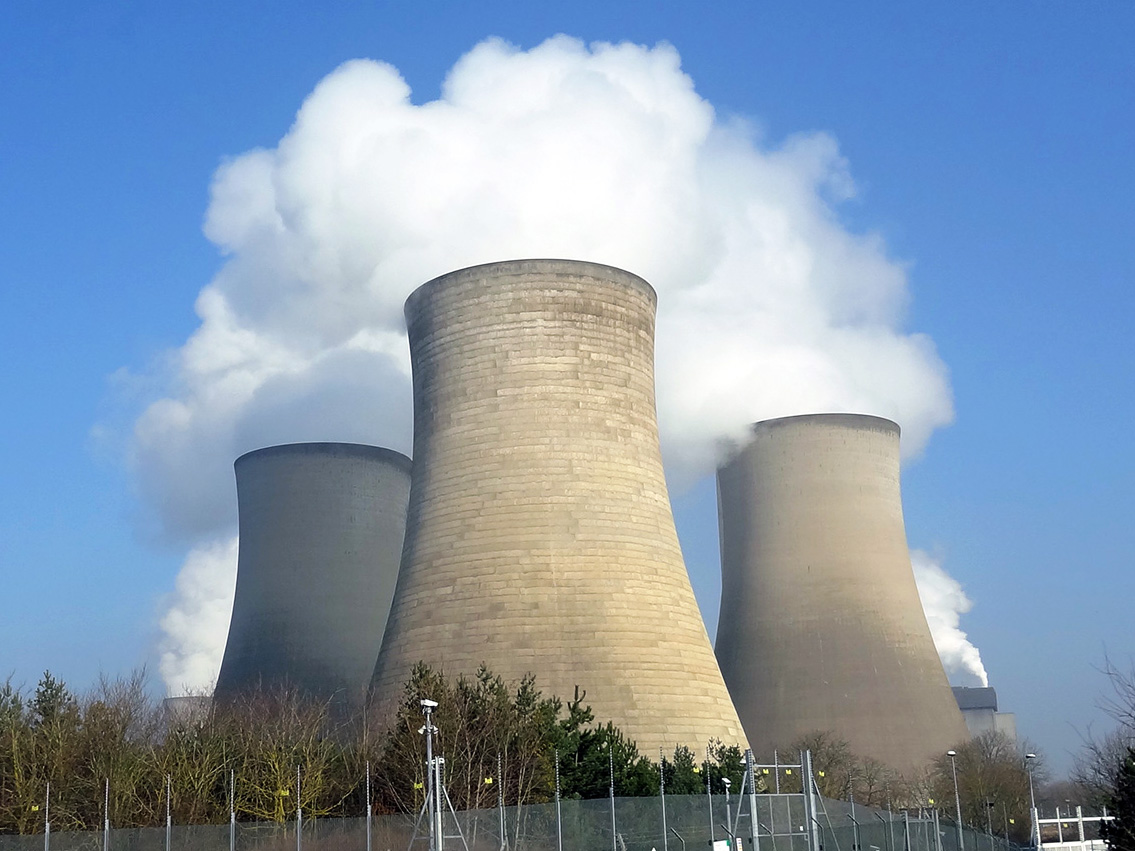Time to address global warming
 In December 2015, countries from around the world met in Paris at the United Nations Intergovernmental Panel on Climate Change (IPCC). The key element of the resulting Paris Agreement was to keep ‘global temperature rise this century well below 2 degrees Celsius above pre-industrial levels and to pursue efforts to limit the temperature increase even further to 1.5 degrees Celsius.’ At the same time it was agreed that the IPCC would conduct an analysis of what would need to be done to limit global warming to 1.5°C. The IPPC has just published its report.
In December 2015, countries from around the world met in Paris at the United Nations Intergovernmental Panel on Climate Change (IPCC). The key element of the resulting Paris Agreement was to keep ‘global temperature rise this century well below 2 degrees Celsius above pre-industrial levels and to pursue efforts to limit the temperature increase even further to 1.5 degrees Celsius.’ At the same time it was agreed that the IPCC would conduct an analysis of what would need to be done to limit global warming to 1.5°C. The IPPC has just published its report.
The report, based on more than 6000 scientific studies, has been compiled by more than 80 of the world’s top climate scientists. It states that, with no additional action to mitigate climate change beyond that committed in the Paris Agreement, global temperatures are likely to rise to the 1.5°C point somewhere between 2030 and 2040 and then continue rising above that, reaching 3°C by the end of the century.
 According to the report, the effects we are already seeing will accelerate. Sea levels will rise as land ice caps and glaciers melt, threatening low lying coastal areas; droughts and floods will become more severe; hurricanes and cyclones will become stronger; the habits of many animals will become degraded and species will become extinct; more coral reefs will die and fish species disappear; more land will become uninhabitable; more displacement and migration will take place, leading to political tensions and worse.
According to the report, the effects we are already seeing will accelerate. Sea levels will rise as land ice caps and glaciers melt, threatening low lying coastal areas; droughts and floods will become more severe; hurricanes and cyclones will become stronger; the habits of many animals will become degraded and species will become extinct; more coral reefs will die and fish species disappear; more land will become uninhabitable; more displacement and migration will take place, leading to political tensions and worse.
Two tragedies

The problem of greenhouse gas emissions and global warming is a classic case of the tragedy of the commons. This is where people overuse common resources, such as open grazing land, fishing grounds, or, in this case, the atmosphere as a dump for emissions. They do so because there is little, if any, direct short-term cost to themselves. Instead, the bulk of the cost is borne by others – especially in the future.
There is another related tragedy, which has been dubbed the ‘tragedy of incumbents’. This is a political problem where people in power  want to retain that power and do so by appealing to short-term selfish interests. The Trump administration lauds the use of energy as helping to drive the US economy and make people better off. To paraphrase Donald Trump ‘Climate change may be happening, but, hey, let’s not beat ourselves up about it and wear hair shirts. What we do will have little or no effect compared with what’s happening in China and India. The USA is much better off with a strong automobile, oil and power sector.’
want to retain that power and do so by appealing to short-term selfish interests. The Trump administration lauds the use of energy as helping to drive the US economy and make people better off. To paraphrase Donald Trump ‘Climate change may be happening, but, hey, let’s not beat ourselves up about it and wear hair shirts. What we do will have little or no effect compared with what’s happening in China and India. The USA is much better off with a strong automobile, oil and power sector.’
What’s to be done?
According to the IPCC report, if warming is not to exceed 1.5℃, greenhouse gas emissions must be reduced by 45% by 2030 and by 100% by around 2050. But is this achievable?
 The commitments made in the Paris Agreement will not be nearly enough to achieve these reductions. There needs to be a massive movement away from fossil fuels, with between 70% and 85% of global electricity production being from renewables by 2050. There needs to be huge investment in green technology for power generation, transport and industrial production.
The commitments made in the Paris Agreement will not be nearly enough to achieve these reductions. There needs to be a massive movement away from fossil fuels, with between 70% and 85% of global electricity production being from renewables by 2050. There needs to be huge investment in green technology for power generation, transport and industrial production.
In addition, the report recommends investing in atmospheric carbon extraction technologies. Other policies to reduce carbon include massive reforestation.
Both these types of policies involve governments taking action, whether through increased carbon taxes on either producers or consumer or both, or through increased subsidies for renewables and other alternatives, or through the use of cap and trade with emissions allocations (either given by government or sold at auction) and carbon trading, or through the use of regulation to prohibit or limit behaviour that leads to emissions. The issue, of course, is whether governments have the will to do anything. Some governments do, but with the election of populist leaders, such as President Trump in the USA, and probably Jair Bolsonaro in Brazil, and with sceptical governments in other countries, such as Australia, this puts even more onus on other governments.
Another avenue is a change in people’s attitudes, which may be influenced by education, governments, pressure groups, news media, etc. For example, if people could be persuaded to eat less meat, drive less (for example, by taking public transport, walking, cycling, car sharing or living nearer to their work), go on fewer holidays, heat their houses less, move to smaller homes, install better insulation, etc., these would all reduce greenhouse gas emissions.
 Finally, there is the hope that the market may provide part of the solution. The cost of generating electricity from renewables is coming down and is becoming increasingly competitive with electricity generated from fossil fuels. Electric cars are coming down in price as battery technology develops; also, battery capacity is increasing and recharging is becoming quicker, helping encourage the switch from petrol and diesel cars to electric and hybrid cars. At the same time, various industrial processes are becoming more fuel efficient. But these developments, although helpful, will not be enough to achieve the 1.5°C target on their own.
Finally, there is the hope that the market may provide part of the solution. The cost of generating electricity from renewables is coming down and is becoming increasingly competitive with electricity generated from fossil fuels. Electric cars are coming down in price as battery technology develops; also, battery capacity is increasing and recharging is becoming quicker, helping encourage the switch from petrol and diesel cars to electric and hybrid cars. At the same time, various industrial processes are becoming more fuel efficient. But these developments, although helpful, will not be enough to achieve the 1.5°C target on their own.
Videos and audio
 IPCC climate change report
IPCC climate change report- Climate change: How 1.5 degrees could change the world
 Climate change: What would you be prepared to do?
Climate change: What would you be prepared to do? Why we’re heading for a ‘climate catastrophe’
Why we’re heading for a ‘climate catastrophe’ Earth has 12 years to avert climate change catastrophe, warns UN report
Earth has 12 years to avert climate change catastrophe, warns UN report Press briefing
Press briefing Climate Change
Climate Change
Australian Academy of Science on YouTube (7/10/18)
BBC News, Laura Foster (8/10/18)
BBC News (8/10/18)
BBC Newsnight (8/10/18)
CNN, Jim Skea, co-chair of IPCC working group III (8/10/18)
IPCC, Monica Villela Grayley, Spokesperson for the President of the General Assembly (8/10/18)
BBC’s The Moral Maze, chaired by Michael Buerk (10/10/18)
Articles
- We must reduce greenhouse gas emissions to net zero or face more floods
- Rapid, unprecedented change needed to halt global warming – U.N.
- Final call to save the world from ‘climate catastrophe’
- New UN report outlines ‘urgent, transformational’ change needed to hold global warming to 1.5°C
- Earth’s temperature to rise 1.5C as early as 2030 amid dire warnings from UN climate panel
- UN Climate Change Report: Everything You Need To Know
- Thirty years of the IPCC
- 13 things you should know about 1.5
- Climate change impacts worse than expected, global report warns
- World to miss Paris climate targets by wide margin, says UN panel
- We have 12 years to limit climate change catastrophe, warns UN
- Limiting warming to 1.5C is possible – if there is political will
- The Trump administration has entered Stage 5 climate denial
- ‘Unprecedented changes’ needed to stop global warming as UN report reveals islands starting to vanish and coral reefs dying
The Guardian, Nicholas Stern (8/10/18)
Reuters, Nina Chestney and Jane Chung (8/10/18)
BBC News, Matt McGrath (8/10/18)
The Conversation, Mark Howden and Rebecca Colvin (8/10/18)
The Telegraph (8/10/18)
Huffington Post, Isabel Togoh (8/10/18)
Physics World (8/10/18)
Unearthed, Zach Boren (8/10/18)
National Geographic, Stephen Leahy (7/10/18)
Financial Times, Leslie Hook (8/10/18)
The Guardian, Jonathan Watts (8/10/18)
The Guardian, Christiana Figueres (8/10/18)
The Guardian, Dana Nuccitelli (8/10/18)
Independent, Josh Gabbatiss (8/10/18)
Report
- Global Warming of 1.5 °C
Intergovernmental Panel on Climate Change (IPCC) (8/10/18)
Questions
- Explain the extent to which the problem of global warming is an example of the tragedy of the commons. What other examples are there of the tragedy?
- Explain the meaning of the tragedy of the incumbents and its impact on climate change? Does the length of the electoral cycle exacerbate the problem?
- With the costs of low or zero carbon technology for energy and transport coming down, is there as case for doing nothing in response to the problem of global warming?
- Examine the case for and against using taxes and subsidies to tackle global warming.
- Examine the case for and against using regulation to tackle global warming.
- Examine the case for and against using cap-and-trade systems to tackle global warming.
- Is there a prisoners’ dilemma problem in getting governments to adopt policies to tackle climate change?
- What would be the motivation for individuals to ‘do their bit’ to tackle climate change? Other than altering prices or using regulation, how might the government or other agencies set about persuading people to ‘be more green’?
- If you were doing a cost–benefit analysis of some project that will have beneficial environmental impacts in the future, how would you set about adjusting the values of these benefits for the fact that they occur in the future and not now?